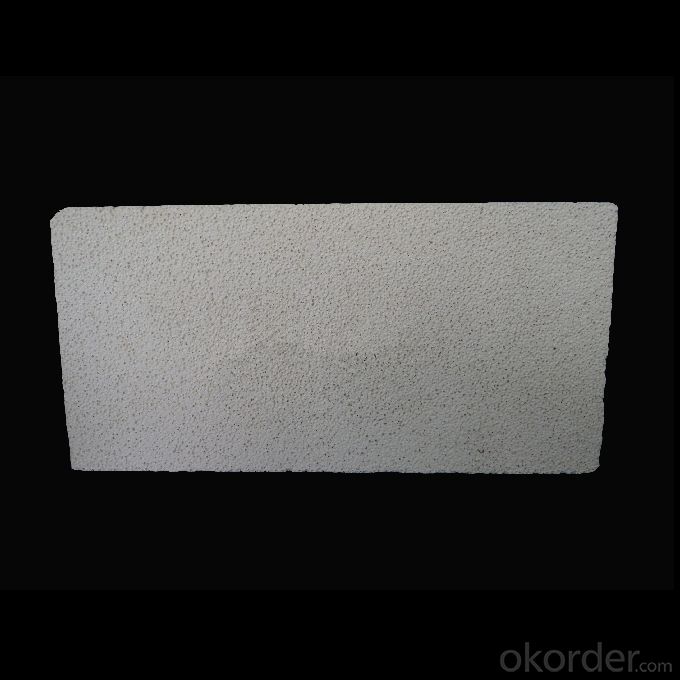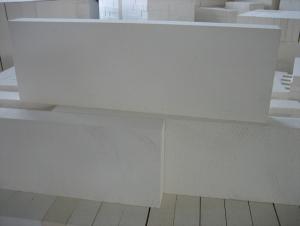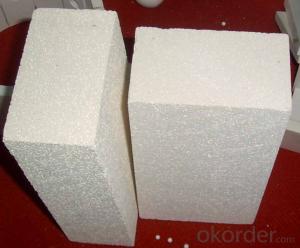Refractory Mullite Insulating Refractory Brick JM 25
- Loading Port:
- Shanghai
- Payment Terms:
- TT OR LC
- Min Order Qty:
- 20 m.t.
- Supply Capability:
- 20 m.t./month
OKorder Service Pledge
OKorder Financial Service
You Might Also Like
Okorder series heat insulation brick
Okorder series thermal insulation brick is an effective, energy saving, low carbon, environmental protection advanced, according to the ASTM standard manufacturing products. Okorder series products have all kinds of materials in the field of metallurgy, industrial furnaces, aluminum, the best Li Ning petrochemical and insulation, electric power and glass ceramics. They can be used as part of an insulation or not to melt. Products have been widely used in the following furnace, achieved satisfactory results.
Application of heat preservation brick
Metallurgical Industry: blast furnace, hot blast furnace, heating furnace, etc..
Petrochemical Industry: ethylene cracking furnace, hydrogen furnace, the main furnace, heating furnace, etc..
Ceramic industry: roller kiln, kiln, etc..
Glass industry: glass furnace regenerator, etc.
Carbon industry: carbon furnace, etc..
Aluminum electrolysis industry: aluminum reduction cell, etc.
Other industries: tunnel kiln, shuttle kiln, etc..
Advantages of heat insulation brick
Low thermal conductivity: many air holes will bring good thermal insulation effect, energy saving.
High crushing strength: high crushing strength, volume stability.
Low heat storage: small heat storage, absorb more heat, energy-saving effect is obvious.
Chundu: High-speed Rail, low content of alkali metal impurities.
Accuracy: the size of the brick machining precision, cutting and grinding the special shape, speed up the brick.
Technical Data
ITEM | GJM30 | GJM28 | GJM26 | GJM23 |
Classification Temperature, ℉/℃ | 3000/1650 | 2800/1540 | 2600/1430 | 2300/1260 |
Bulk Density,g/cm³ | ≤1.0 | ≤0.9 | ≤0.8 | ≥0.5 |
Reheating Linear Change, % | ≤0.9 (1550℃,12 h) | ≤0.8 (1510℃,12 h) | ≤0.7 (1410℃,12 h) | ≤0.5 (1230℃,12 h) |
Al2O3 Content, % | ≥75 | ≥65 | ≥55 | ≥45 |
Fe2O3 Content, % | ≤0.5 | ≤0.6 | ≤0.7 | ≤1.0 |
Thermal Conductivity: | ||||
800℃, w/m.k | ≤0.39 | ≤0.37 | ≤0.35 | ≤0.18 |
1000℃, w/m.k | ≤0.43 | ≤0.41 | ≤0.39 | ≤0.20 |
1200℃, w/m.k | ≤0.48 | ≤0.46 | ≤0.43 | --- |
Insulating brick

- Q:Are insulating fire bricks resistant to oil and gas?
- Insulating fire bricks typically offer resistance against oil and gas. These bricks are crafted from high temperature materials like alumina and silica, which grant exceptional thermal insulation qualities and can endure elevated temperatures. They are commonly employed in industries where exposure to heat occurs, such as furnaces, kilns, and fireplaces. Nevertheless, it is crucial to acknowledge that the resistance to oil and gas can vary depending on the precise composition and manufacturing process of the insulating fire bricks. Certain bricks may exhibit higher resistance to oil and gas compared to others. To guarantee the utmost resistance to oil and gas, it is recommended to utilize insulating fire bricks that are specifically engineered for such applications. These bricks are often known as oil and gas resistant fire bricks and are formulated with supplementary additives or coatings that enhance their resistance to these substances. In conclusion, although insulating fire bricks generally offer resistance to oil and gas, it is advisable to employ bricks that are specifically tailored for such applications to ensure optimal performance and longevity.
- Q:Can insulating fire bricks be used in the construction of gas kilns?
- Indeed, it is possible to utilize insulating fire bricks in the construction of gas kilns. These bricks are specifically designed to possess low thermal conductivity, enabling them to retain heat effectively and enhance the kiln's energy efficiency. To guarantee the even distribution and maintenance of heat within the kiln chamber, proper insulation is necessary for gas kilns. By employing insulating fire bricks to line the walls, floor, and ceiling of the kiln, a barrier is created that aids in the prevention of heat loss and ultimately improves the kiln's overall performance. Furthermore, due to their lightweight nature and ease of handling, insulating fire bricks have become a favored choice for kiln construction projects.
- Q:Can insulating fire bricks be used in chimneys or flues?
- Yes, insulating fire bricks can be used in chimneys or flues. These bricks are designed to withstand high temperatures and provide excellent insulation, making them suitable for lining chimneys and flues to prevent heat transfer and improve overall efficiency.
- Q:What is the difference between the production line of foamed cement insulation bricks and the self thermal insulation block production line?
- Yes, this year's business is not very good to do, customers pay more attention to the quality of products, seven industrial equipment, very satisfied with the service OK
- Q:Can insulating fire bricks be used in hydrogen furnaces?
- Insulating fire bricks can be used in hydrogen furnaces, but it is important to note that not all types of insulating fire bricks are suitable for this application. Hydrogen is a highly reactive gas and can cause certain materials to degrade or react, leading to safety concerns and potential damage to the furnace. When selecting insulating fire bricks for use in hydrogen furnaces, it is crucial to choose bricks that are specifically designed for high-temperature and corrosive environments. These bricks should be made from materials that are resistant to hydrogen embrittlement and have low reactivity with hydrogen. Silicon carbide (SiC) and alumina-silica (Al2O3-SiO2) are commonly used materials for insulating fire bricks in hydrogen furnaces. These materials have good resistance to high temperatures and are chemically stable in the presence of hydrogen. It is also important to consider the density and porosity of the insulating fire bricks. Low-density bricks with high porosity are preferred for hydrogen furnaces as they provide better thermal insulation and reduce the risk of hydrogen leakage. Overall, while insulating fire bricks can be used in hydrogen furnaces, it is crucial to select the appropriate type of bricks that are specifically designed for high-temperature and corrosive environments, and have good resistance to hydrogen embrittlement and reactivity. Consulting with experts in the field and following the manufacturer's guidelines is highly recommended to ensure the safe and efficient operation of the hydrogen furnace.
- Q:What bricks are thermal insulation bricks?
- Insulating bricks, a new type of product that can replace tiles, are mainly used in toilets, kitchens, TV sets, bedrooms, walls and so on. And brightly colored, various specifications, can be cut at random, the section neatly.
- Q:Masonry method for boiler refractory brick
- Furnace wall gas tightness requirements, gray seam fullness requirements: red brick is not less than 85%; refractory brick not less than 90%. When the red brick is built, the method of squeezing is adopted, and the construction of the refractory brick is constructed by scraping.
- Q:Can insulating fire bricks be used for chimney lining?
- Yes, insulating fire bricks can be used for chimney lining. Insulating fire bricks are designed to withstand high temperatures and are excellent for insulating chimneys, providing thermal protection and enhancing energy efficiency.
- Q:Can insulating fire bricks be used in residential construction?
- Yes, insulating fire bricks can be used in residential construction. They are commonly used to line fireplaces, wood-burning stoves, and other heating appliances in homes. These bricks are designed to withstand high temperatures and provide excellent thermal insulation, making them suitable for residential applications where heat retention and fire protection are important factors.
- Q:Can insulating fire bricks be used in the construction of BBQ pits?
- Yes, insulating fire bricks can be used in the construction of BBQ pits. Insulating fire bricks are designed to withstand high temperatures and have excellent heat resistance properties, making them ideal for use in BBQ pits. These bricks help trap and distribute heat evenly, resulting in more efficient cooking and a better BBQ experience. Additionally, insulating fire bricks also help to reduce heat loss, ensuring that the BBQ pit retains and maintains heat for a longer period. Overall, using insulating fire bricks in the construction of BBQ pits can greatly enhance the performance and longevity of the pit.
1. Manufacturer Overview |
|
|---|---|
| Location | |
| Year Established | |
| Annual Output Value | |
| Main Markets | |
| Company Certifications | |
2. Manufacturer Certificates |
|
|---|---|
| a) Certification Name | |
| Range | |
| Reference | |
| Validity Period | |
3. Manufacturer Capability |
|
|---|---|
| a)Trade Capacity | |
| Nearest Port | |
| Export Percentage | |
| No.of Employees in Trade Department | |
| Language Spoken: | |
| b)Factory Information | |
| Factory Size: | |
| No. of Production Lines | |
| Contract Manufacturing | |
| Product Price Range | |
Send your message to us
Refractory Mullite Insulating Refractory Brick JM 25
- Loading Port:
- Shanghai
- Payment Terms:
- TT OR LC
- Min Order Qty:
- 20 m.t.
- Supply Capability:
- 20 m.t./month
OKorder Service Pledge
OKorder Financial Service
Similar products
New products
Hot products
Related keywords




























